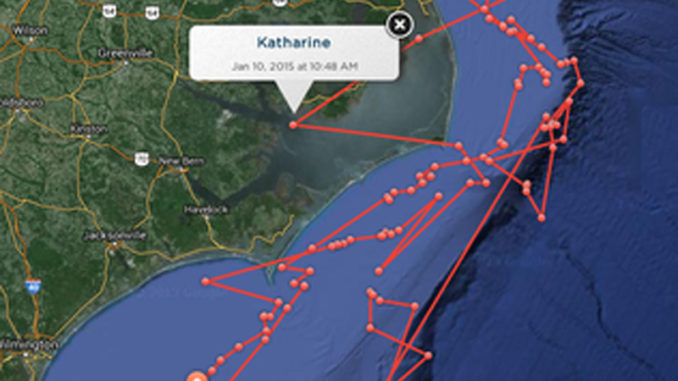
Katharine, a 14-footer, entered Pamlico Sound through Oregon Inlet, toured North Carolina’s huge inland sound
A tracking device indicated that a “famous” 14-foot great white shark, tagged in 2013 off the Massachusetts coast, apparently swam through Oregon Inlet, into and around Pamlico Sound during the second week of January.
After making a few circuits of the massive inland bay, the 2,300-pound beast, first captured and named Katharine by research group OCEARCH, headed out Hatteras Inlet and resumed cruising in the Atlantic Ocean, headed south.
The shark-tracking group said in a bulletin that a device inserted in the fish’s dorsal fin revealed the shark’s location south of Oregon Inlet on Friday night, Jan. 9, but the next ping came Saturday at the mouth of the Pamlico River near Belhaven. Later that day, Katharine was in the ocean near Hatteras Island.
OCEARCH officials said they weren’t surprised by the shark’s southerly trail, which they said is a normal path for a great white during winter. The sharks likely are following food sources and return north during spring, as they trail northerly migrating oceanic species.
The shark apparently spent 13 hours in Pamlico Sound, a relatively shallow body of water with depths only reaching 26 feet. What made its visit unusual was places that shallow normally don’t attract big sharks, unless there’s an abundance of seals. Otherwise, great whites normally are bluewater species.
The tracking device on the shark’s dorsal fin emits a GPS signal that’s picked up by a stationary satellite and relayed to earth whenever the fin breaks the water’s surface.
Some observers were skeptical that the shark made its way through Hatteras Inlet, which also is shallow, but Brian Dorn of the N.C. Aquarium on Roanoke Island, said in a news account he had confidence in the satellite tracking.
“I think it’s real,” he said. “Satellite tracking has been pretty accurate to this point. “(OCEARCH researchers) were surprised she went in that far, (but) they’ve seen similar trackings on other great whites. She may have sensed there was food up there. It may have just been an exploratory passageway she took, not necessarily even smelling food, just traveling through local waters.
“But Katharine not staying in the sound very long probably was because of the conditions of the mostly brackish estuary, especially on the western side. Once it gets a little bit fresher, she probably wanted to find a way out, and she did.”
After spending Saturday at Diamond Shoals, Katharine headed farther south, popping up to surface multiple times through Jan. 12 off Core Banks and Cape Lookout National Seashore. She later was detected off Wilmington.
Katharine was captured and tagged off Cape Cod in 2013 aboard a custom built-vessel, the M/V OCEARCH, which uses a hydraulic platform to lift mature sharks for access by research teams. As many as 12 studies may be taken in 15 minutes on a shark before its release.
OCEARCH is a non-profit that tags and tracks sharks on computer software available to the public. Details about Katharine, including live tracking data, is at at www.ocearch.org/profile/katharine/.




Be the first to comment